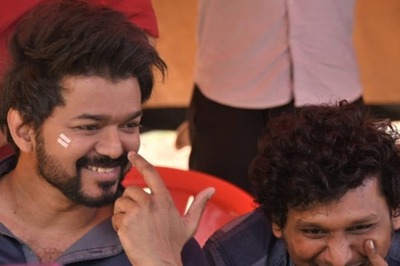
views
Madhu Jain, popularly known as Indian revivalist, brought to ramp a lineup of indigenous ensembles, which in reality were an amalgamation of 30 years of her hard work. The show opened with one of her family members crooning ‘You look wonderful tonight’ and ‘Can’t help falling in love’ and then featured models sashaying down the runway to the tunes of Carnatic music.
Having been in the industry for so long, Madhu chose to make her Amazon India Fashion Week debut just with this edition. When asked what kept her away, the designer laughed and said, “The ethos of my label is to use weaves as a form of embellishments and to work with crafts and this is what I’ve been doing in the last 30 years.”
“In between crafts were not fashionable, weaves were not fashionable and people would opt for machine made fibers rather than man-made fibers so it wasn’t really my scene. I opted for research and that’s the time I decided to strengthen my knowledge – grassroot level to be able to work with different crafts and that’s what I was doing,” she added.

When News18.com asked whether the sudden revival of Indian textiles is the rage because of PM Modi’s government initiative, the designer promptly said, “I feel fashion and politics don’t go together.”
She further credited FDCI’s President Sunil Sethi for his collaborative efforts and the far-sighted vision. “If you have FDCI with a vision and the person heading it has a vision , things automatically change –Mr Sethi was worked with tandem in Ministry and has tried to bridge the gap between the ministry and the fashion world.”
Known primarily for her installations, the designer has been associated to quite a lot of interesting projects including the restoration of sari worn during Pandit Nehru’s time in 1941 and the commonwealth opening ceremony.
For her first show, the designer arranged the ensembles from her near ones who owned ‘Madhu Jain’ in their wardrobes and brought to ramp her quintessential ladies as showstoppers debunking all age stereotypes.

She has no qualms in accepting that even though Indian weaves is now a “dying-out craft”, certain initiatives can help improve the situation.
“The first generation of weavers, they don’t have a second generation. They don’t want their children to take on so you’ve to make it lucrative enough to continue the legacies of the family – you’ve to give them incentives.”
She’s also of the view that Indian textiles and weaves have already made a mark on the global platform with so many International designers coming to India for sourcing but adds that the priorities of Indian buyers and designers need to change. “It’s just that Indians need to realise that our strength is not western cuts and silhouettes. Our strength is our textiles.”
She presented her collection on day 1 of the 4-day long fashion extravaganza. Ace designers Tarun Tahiliani and Amit Aggarwal will present the magnum opus grand finale on March 18.




















Comments
0 comment